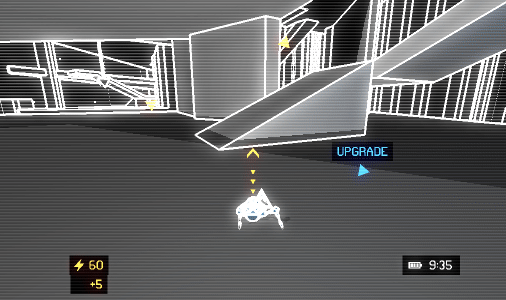Another design overhaul
It bugs me to have two modes of gameplay (overworld and PvP) so explicitly delineated and separate. It makes the game lean too far toward the multiplayer category and makes the singleplayer story aspects feel tacked-on. I want the two to be truly integrated in a meaningful way.
So instead of abruptly kicking you out to the overworld, I'm just going to pull up the UI right there in-game while you wander around. This means that I'm cautiously inching back toward the old exploration mode. Which is great because I've been dying to somehow get my colors back in.
It will be more integrated than it used to be. Previously the game would completely reload the level, setting the meshes to be colored or B&W depending on the mode. Now it's just a render flag which I can toggle at any time.
So the idea is, you'll be in exploration mode, you'll enter a new area, find a control panel, and start capturing the area. You might capture the zone before the owner can defend it, or they might spawn in right away and stop you.
There's still a lot to think about, especially what happens if you lose. I think I want some form of permadeath for the player character.
Netcode
Progress continues. First I got positions and orientations synced in a naive, brute-force manner. Then I implemented delta compression so that only moving objects are sent every frame. My first try was less than perfect:

But I got it working. At this point the client was basically in spectator mode; there was no player input.
After synchronizing a few player configuration variables like usernames etc., I started sending player input from the client to the server. It's important that I don't have the server just trust whatever position the client says the player is at; a system like that would be hacked almost instantly.
I was surprised to see how accurate dead-reckoning on the server was, even with low float precision. I'm currently using dead-reckoning, plus the server accepts the client's exact position as canonical if it's within a small tolerance of where the server thinks it should be.
Here's how it works in practice. The white triangle shows where the server thinks the player is.

There are still tons of issues to tackle, but it's looking feasible. I also tested the game with my linux VM in NYC. It survived its first contact with real-world internet conditions, so that's encouraging.
Here's a dev stream recording of some of these netcode features being coded.
New culling effect
If you look at the old culling effect, you can see the inside of the geometry you're currently crawling on. I turned off back-face culling to make this work, and it looked fine. However, you could often rotate the camera and see all the backfaces of the outside of the level, which looked tacky. Plus, disabling back-face culling entails a significant performance hit.
So I re-enabled back-face culling and I black out everything you shouldn't be able to see with a cylinder. Works surprisingly well.


